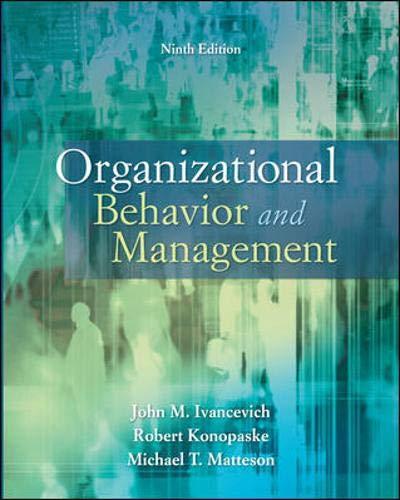You will never meet Catherine, Anna, Maria, or Monica. But the future success of Swedens Electrolux depends
Question:
You will never meet Catherine, Anna, Maria, or Monica. But the future success of Sweden’s Electrolux depends on what these four women think.
Catherine, for instance, a Type A career woman who is a perfectionist at home, loves the idea of simply sliding her laundry basket into a washing machine, instead of having to lift the clothes from the basket and into the washer. That product idea has been moved onto the fast track for consideration.
So, just who are Catherine and the other women?
Well, they don’t actually exist. They are composites based on in-depth interviews with some 160,000 consumers from around the globe. To divine the needs of these mythical customers, 53 Electrolux employees, including designers, engineers, and marketers hailing from various divisions, gathered in Stockholm for a weeklong brainstorming session. The Catherine team began by ripping photographs out of a pile of magazines and sticking them onto poster boards. Next to a picture of a woman wearing a sharply tailored suit, they scribbled some of Catherine’s attributes: driven, busy, and a bit overwhelmed.
With the help of these characters, Electrolux designers and engineers are searching for the insights they’ll need to dream up the next batch of hot products.
It’s a new way of doing things for Electrolux, but then again, a lot is new at the company. When Chief Executive Hans Stråberg took the helm in 2002, the world’s No. 2 maker of home appliances after Whirlpool Corp. faced spiraling costs while its middle-market products were gradually losing out to cheaper goods from Asia and Eastern Europe.
Competition in the United States, where Electrolux gets 40 percent of its sales, was ferocious. The company’s stock was treading water.
Stråberg had no choice but to do something radical.
He began shuttering plants in Western Europe and the United States and shifting work to lowercost locales in Asia and Eastern Europe. He also is spinning off the outdoor products division. But this is no ordinary corporate makeover. Stråberg is also breaking down barriers between departments and forcing his designers, engineers, and marketers to work together to come up with new products. To speed the transition, he recruited executives from companies with strong track records in innovation, including Procter & Gamble and PepsiCo.
At the Stockholm brainstorming session, for example, the group leader, Kim Scott, was a recent P&G defector. She urged everyone “to think of yourselves as Catherine.” The room buzzed with discussion. Ideas were refined, sketches drawn up. The group settled on three concepts: Breeze, a clothes steamer that also removes stains; an Ironing Center, similar to a pants press but for shirts; and Ease, the washing machine that holds a laundry basket inside its drum.
Half the group raced off to the machine shop to turn out a prototype for Breeze, while the rest stayed upstairs to bang out a marketing plan. Over the next hour, designer Lennart Johansson carved and sandpapered a block of peach-colored polyurethane until a contraption that resembled a cross between an electric screwdriver and a handheld vacuum began to emerge. The designers in the group wanted the Breeze to be smaller, but engineer Giuseppe Frucco pointed out that would leave too little space for a charging station for the 1,500-watt unit.
For company veterans such as Frucco, who works at Electrolux’s fabric care research and development center in Porcia, Italy, this dynamic groupthink is a refreshing change: “We never used to create new products together,” he says. “The designers would come up with something and then tell us to build it.”
The new way saves time and money by avoiding the technical glitches that crop up as a new design moves from the drafting table to the factory floor.
To support the innovation drive, Stråberg has bumped up spending on R&D from 0.8 percent of sales to 1.2 percent and is aiming for 2 percent eventually.
What he’s gunning for are products that consumers will gladly pay a premium for: gadgets with drop-dead good looks and clever features that ordinary people can understand without having to pore through a thick users’
manual. “Consumers are prepared to pay for good design and good performance,” he says.
Electrolux isn’t the only appliance maker on an innovation kick. In 1999, Whirlpool Corp. launched a program that allows all of its 68,000 employees to contribute design ideas, yielding a flood of new products.
Questions 1. How did Electrolux Chief Executive Stråberg break down barriers (and increase communication) between departments? Why did he do this? Explain.
2. What are the advantages for Electrolux of having individuals from different departments and functional areas work together on product design? Describe.
3. In an era with intense competition and several lowcost products on the market, how can Electrolux use teamwork and groups to succeed? Describe.
Step by Step Answer:

Organizational Behavior And Management
ISBN: 9780073530505
9th Edition
Authors: John Ivancevich, Robert Konopaske, Michael T Matteson





